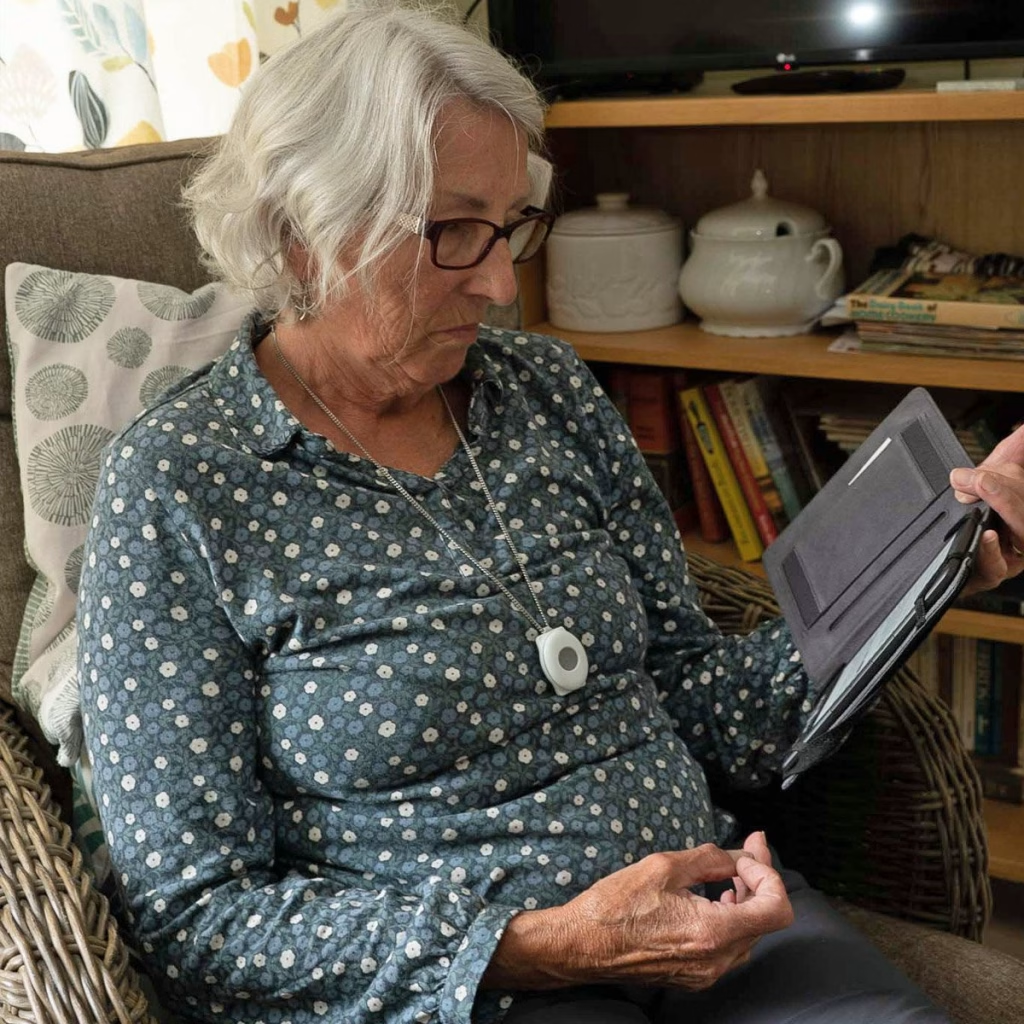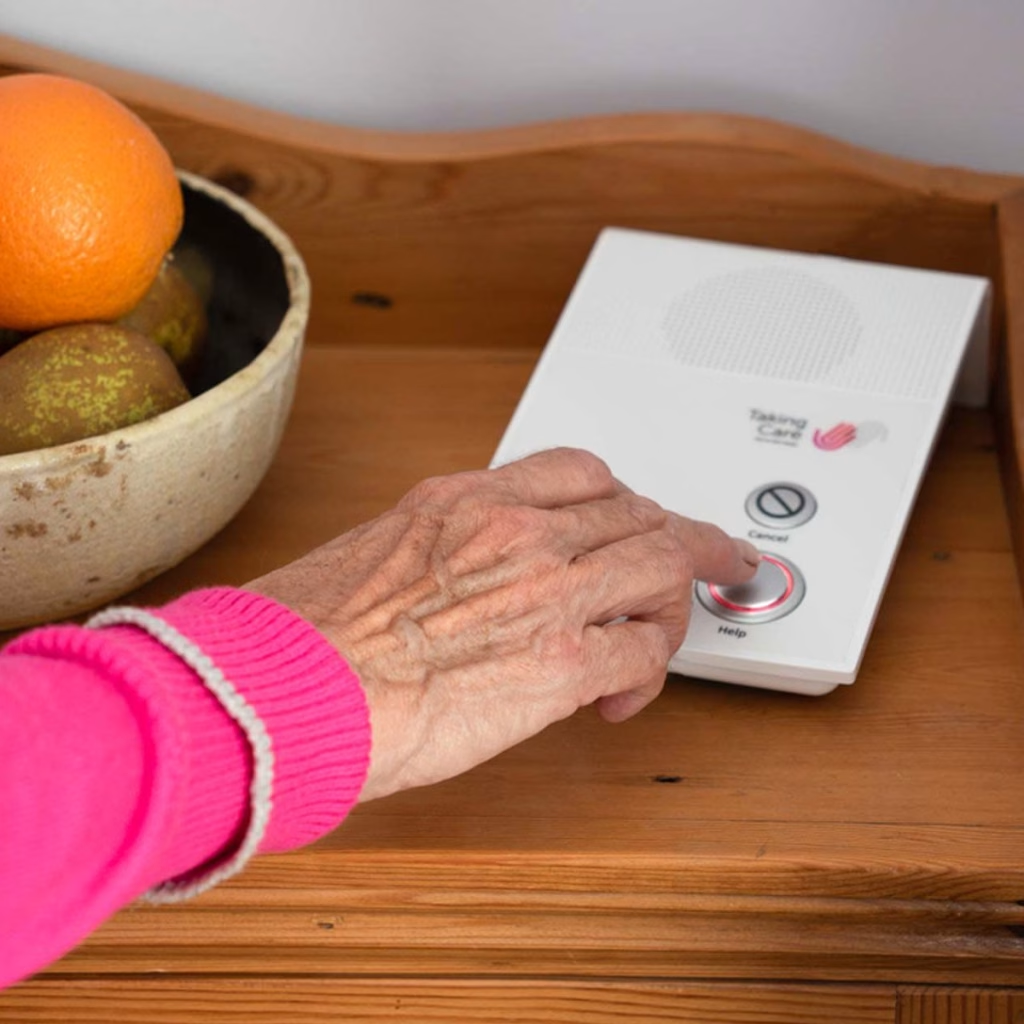Feel Safer at Home: How Personal Alarms Support Stairlift Users

For individuals with restricted mobility, safety and independence are top priorities when it comes to living at home. Having a stairlift fitted can feel like a new lease of life, making it easier to get around your home. But even with home adaptations in place, accidents can still occur from trips and falls, often when help is not readily available.
Table of Contents
Whether you use a stairlift yourself or you’re supporting a loved one who does, you may be wondering what more can be done to provide peace of mind, especially in the event of a fall or medical emergency. That’s where personal alarms can prove to be beneficial. In this article, we explore what a personal alarm is, how they work, why personal alarms are particularly useful for stairlift users, and how to choose the right type of system for your needs.
What Is A Personal Alarm
A personal alarm is a small, wearable device with an easy-to-press button, often worn as a pendant or wristband, that allows the user to quickly call for help if something goes wrong, such as a fall, sudden illness, or feeling distressed at home.
A personal alarm typically has the following features;
- An easy-to-press emergency button: Once the button is pressed, the alarm automatically sends an alert to a 24/7 Emergency Resolution Team.
- Base unit: some in-home personal alarms come with a base unit that can be easily plugged in, and ready to use as soon as the personal alarm is activated.
- Water-resistant pendant: most personal alarms are water-resistant, so you don’t have to take them off in the shower or bathroom – a common place for falls.
- Two-way communication: the pendant or base unit will have a built-in speaker and microphone. This allows for two-way communication between the user and the Emergency Resolution Team, without the need for a mobile phone.
- Long battery life: Some in-home personal alarms have a battery life of 6 years, so you don’t have to worry about recharging them time and again. Personal alarms with features such as GPS tracking so they work out-and-about and at home have a shorter battery charge, typically one to two months.
- Wireless connectivity: all newer digital alarms come with a SIM card, so you don’t have to worry about connecting them to a telephone landline or whether they will work after the Digital Switchover.
How Does A Personal Alarm Work?
Personal alarms are simple and intrusive, providing a reliable way to call for help at the press of a button.
- Press the emergency button when you need help.
- Once the button is pressed, the alarm automatically calls the 24/7 Emergency Resolution Team.
- The team will speak with you and assess your situation.
- Based on the situation, the team decides if they need to reach out to your designated contacts, such as a family member, close friend, or neighbour, to make sure you get the support you need.
- If medical assistance is needed, they will call the emergency services. They will keep you updated with the plan of action so you are not left unattended or scared.

Why Stairlift Users May Benefit From a Personal Alarm?
If you use a stairlift, you’re already taking proactive steps to stay safe and independent at home. But while stairlifts reduce the risk of falls on the stairs, they can’t prevent every potential hazard in daily life:
- Falls when getting to or from the stairlift especially if balance or strength is limited.
- Trips in other areas of the home, like slippery bathroom floors or cluttered hallways.
- Health-related emergencies, such as dizziness, low blood pressure, or a sudden illness that are often unpredictable.
If you live alone or have long periods without someone nearby, reaching for a landline or mobile phone might not be practical in an emergency, particularly after a fall, when movement can be difficult or painful. A personal alarm can be useful during such situations. With a wearable help button, you can:
- Call for help instantly, even if you can’t get to a phone.
- Speak directly to trained staff, who know your location and medical details.
- Get reassurance quickly, whether it’s a family member being contacted or emergency services dispatched.
For many stairlift users, this added layer of protection brings:
- Confidence to remain living independently, knowing help is always within reach.
- Peace of mind for family and friends, especially those who don’t live nearby.
Why A Mobile Phone Might Not Be Enough
It’s a common question that loved ones ask, “Why can’t my Mum or Dad just use their mobile if they need help?”
While mobile phones are useful for keeping in touch, they aren’t designed for emergencies, especially if the user is elderly, possibly with poor vision or dexterity.
Here’s why a mobile phone may fall short in an emergency:
- Out of reach when it matters most: Phones are often left on kitchen counters, in handbags, or charging in another room. After a fall, trying to reach one might be impossible.
- Hard to use during distress: Smartphone touchscreens require coordination and fine motor skills, which can be difficult after a shock, fall, or when hands are shaking.
- Unreliable battery life: Phones need frequent charging. If the battery runs out at the wrong moment, it won’t be of any use.
- Screen locks delay response: In an emergency, every second counts. Unlocking a phone and finding the right contact takes time that a personal alarm saves.
- No automatic help: Unless a call is placed, a mobile won’t alert anyone. In contrast, some personal alarms have automatic fall detection, triggering help even if the user can’t press a button.
- Lack of a real-time response team: Phones rely on someone answering a call. Personal alarms connect directly to a trained team that act immediately, even if the wearer is confused or unable to speak.
Supporting Independence With The Right Personal Alarm
There’s a common misconception that using a personal alarm means giving up your independence. But in reality, it’s quite the opposite; it’s about protecting your ability to live freely and safely.
For stairlift users and others with mobility challenges, the right personal alarm can transform daily life:
- Reassurance every day: Knowing that help is always just a button press away brings confidence to carry out tasks like getting dressed, cooking, or showering without fear of being left unaided.
- Greater freedom at home and beyond: Many modern personal alarms work both inside and outside the home, encouraging users to garden, walk to the shops, or enjoy hobbies with peace of mind.
- Confidence to stay in your own home longer: It can delay or even prevent the need for residential care, especially when paired with other mobility aids like stairlifts.
- Emotional security for families: When loved ones can’t be close by, a personal alarm bridges that gap. Family members gain comfort knowing their loved one isn’t alone in an emergency, especially at night or during long stretches of the day.
- Choice and control: From simple pendant alarms that alert family, to 24/7 monitored systems with professional support, there’s a wide range of alarms to suit your lifestyle, preferences, and budget.
Compare personal alarms from Taking Care
Find out more about the different types of elderly alarms and how personal alarms work.
Planning for Peace of Mind
If you or someone you care about uses a stairlift, it’s likely that maintaining independence is a top priority. But independence doesn’t mean facing emergencies alone. A personal alarm is an investment in safety, freedom, and peace of mind not just for the wearer, but for the whole family.
Whether you choose a personal alarm that calls family and friends, or one with round-the-clock monitoring from an Emergency Resolution Team, the key benefit remains the same: help is always within reach.